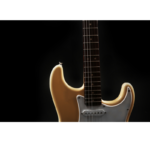As a blues guitarist, the journey to mastering the instrument is paved with iconic songs that shape not only your technique but also your understanding of the genre’s deep emotional connection. Learning classic blues guitar songs allows you to dive into the essence of the blues, discover new techniques, and build the foundation necessary for improvisation and personal style development.
In this article, I’ll guide you through the best blues songs to learn on guitar, explaining how each one will sharpen your skills and deepen your connection with the blues. Whether you’re just starting or looking to advance, these timeless tracks are essential tools for any blues guitarist.
1. “Sweet Home Chicago” – Robert Johnson
One of the quintessential blues songs, “Sweet Home Chicago” by Robert Johnson, is a must-learn for any aspiring blues guitarist. Johnson’s style of fingerpicking and slide guitar laid the foundation for modern blues guitar playing. This song, with its infectious 12-bar blues progression, is perfect for beginners but still challenges more advanced players to work on their rhythm and timing.
Learning “Sweet Home Chicago” gives you insight into the classic 12-bar blues structure, a fundamental element of the genre. Pay close attention to the way Johnson alternates between bass notes and treble strings with his thumb and fingers, a technique that’s essential for mastering blues guitar.
By working on the fingerpicking patterns in this song, you’ll develop coordination between your picking hand and fretting hand, improving your overall dexterity and feel.

🎸 Join the Guitar Freaks Patreon!
Get SoloCraft E-Book FREE!
When you join Guitar Freaks on Patreon, you’ll instantly unlock my full e-book SoloCraft—your complete guide to fretboard mastery and building unforgettable solos. Think of it as your shortcut to playing with confidence and creativity.
👉 Don’t miss out—join now and grab your free copy!
2. “The Thrill Is Gone” – B.B. King
When it comes to developing your phrasing, “The Thrill Is Gone” by B.B. King is an absolute must. B.B. King is famous for his economical playing style, where less is often more. In this song, he uses his vibrato technique and bending notes to convey deep emotion, proving that playing fewer notes can often have a stronger impact than rapid runs.
Learning “The Thrill Is Gone” will help you:
- Master vibrato and string bending, two essential techniques in blues guitar.
- Understand how to phrase your solos with feeling, which is crucial to becoming a more expressive player.
B.B. King’s approach in this song highlights the importance of space between notes. Rather than filling every bar with sound, King allows his notes to breathe, giving them more weight and meaning. This is a critical lesson in understanding the emotional depth of the blues.
3. “Cross Road Blues” – Robert Johnson
Another Robert Johnson classic, “Cross Road Blues”, challenges you to get comfortable with slide guitar and intricate chord progressions. It’s one of the cornerstone songs of delta blues and has been covered by countless musicians, including Eric Clapton and Cream, showcasing its influence on both traditional and modern blues guitar.
The slide work in “Cross Road Blues” helps you:
- Improve slide control and accuracy.
- Learn to use open tunings effectively (typically in open G or open D), which opens up new possibilities for blues guitar playing.
Practicing slide guitar also enhances your ear for microtonal shifts in pitch, as you’ll need to develop a fine sense of intonation to hit the right notes when sliding up and down the neck.
4. “Pride and Joy” – Stevie Ray Vaughan
For those who want to blend blues with a bit of rock edge, “Pride and Joy” by Stevie Ray Vaughan is an exhilarating choice. The song’s mix of blues rhythm with aggressive lead playing shows off Vaughan’s Texas-blues style. It’s fast-paced and requires strong picking technique, making it a great challenge for players who want to push their skills.
By learning “Pride and Joy,” you’ll work on:
- Shuffle rhythm in the context of blues, helping you develop a tight, swinging groove.
- Alternating between rhythm and lead playing within the same song, an essential skill for solo performers and those wanting to play in smaller blues bands.
The main riff is also a fantastic workout for your picking hand, as it combines both upstrokes and downstrokes in a dynamic shuffle pattern that’s core to the Texas blues sound.
5. “Stormy Monday” – T-Bone Walker
T-Bone Walker’s “Stormy Monday” is a slow blues masterpiece that’s packed with jazzy chord voicings and rich harmonic textures. This song offers an opportunity to dive into dominant 9th and 13th chords, which are fundamental in blues and jazz, adding a sophisticated layer to your playing.
Key takeaways from learning “Stormy Monday”:
- You’ll develop a greater understanding of chord extensions, allowing you to add depth and complexity to your blues playing.
- The song’s tempo and feel help you practice playing expressively at a slower pace, something that can be more challenging than fast runs.
Walker’s style was highly influential on later blues guitarists, and studying his technique in this song will broaden your harmonic vocabulary.
6. “Red House” – Jimi Hendrix
Jimi Hendrix is often associated with rock, but his deep connection to the blues is evident in songs like “Red House.” This slow blues track is filled with intricate bends, hammer-ons, and pull-offs, along with Hendrix’s signature use of double stops. Hendrix’s approach to the blues was innovative, pushing boundaries while staying grounded in traditional forms.
Why learn “Red House”?
- It challenges your understanding of phrasing and encourages you to break away from rigid patterns.
- Hendrix’s use of the minor pentatonic scale over the 12-bar structure demonstrates how you can use scales creatively in blues solos.
“Red House” also pushes you to experiment with your amp settings and tone, as Hendrix often employed a more aggressive, saturated sound in his blues playing. This song teaches you how to blend blues with rock, pushing the genre’s boundaries.
7. “Hoochie Coochie Man” – Muddy Waters
“Hoochie Coochie Man” by Muddy Waters is one of the definitive Chicago blues songs. With its stop-time riff and commanding vocal delivery, this song exemplifies the power of simplicity in the blues. The guitar parts in this track are often straightforward but incredibly effective, emphasizing groove and feel over complexity.
By learning “Hoochie Coochie Man,” you’ll:
- Build confidence in your ability to hold down a strong rhythmic groove.
- Learn how to combine simple lead lines with powerful, driving rhythm parts.
This song also offers an introduction to Chicago blues techniques, especially how to play rhythmically tight, short riffs that can cut through the mix in a band setting.
8. “Born Under a Bad Sign” – Albert King
Albert King’s “Born Under a Bad Sign” is another must-learn for blues guitarists. Known for his powerful, stinging bends and heavy use of the minor pentatonic scale, King’s style is an excellent example of economy in soloing. His phrasing is deliberate and always packs a punch, making this song a fantastic study in expressing emotion with just a few notes.
“Born Under a Bad Sign” will help you:
- Master bends and vibrato that are controlled yet powerful.
- Learn how to make the minor pentatonic scale the backbone of your solos.
Albert King’s upside-down, left-handed approach to the guitar gave him a unique sound, and studying his playing in this song will teach you how to incorporate unexpected techniques into your own playing.
9. “I’m Tore Down” – Freddie King
Freddie King’s “I’m Tore Down” is an uptempo blues shuffle that will help you lock into a fast-paced groove. King’s style blends blues and soul, and his rhythmic lead playing is a masterclass in how to keep a solo energetic and tight, even at high speeds.
What you’ll gain from learning “I’m Tore Down”:
- Shuffle rhythm mastery that’s crucial for many blues guitar songs.
- Develop speed and accuracy in your lead playing while maintaining groove.
Freddie King’s approach to soloing is often energetic and punchy, making this song ideal for players looking to add fire to their solos while still staying true to blues traditions.
Conclusion
Learning these classic blues guitar songs not only builds your technical ability but also deepens your connection with the history and emotion of the genre. Whether it’s developing your vibrato with B.B. King, exploring slide guitar with Robert Johnson, or mastering shuffle rhythm with Freddie King, each song provides a unique lesson that will enhance your playing.
As you work through these songs, remember that blues guitar is all about feel. These tracks are more than exercises—they’re opportunities to express emotion, tell a story through your playing, and honor the legacy of the greats who came before. So grab your guitar, dive into these songs, and let the blues guide you to new heights.

🎸 Join the Guitar Freaks Patreon!
Get SoloCraft E-Book FREE!
When you join Guitar Freaks on Patreon, you’ll instantly unlock my full e-book SoloCraft—your complete guide to fretboard mastery and building unforgettable solos. Think of it as your shortcut to playing with confidence and creativity.
👉 Don’t miss out—join now and grab your free copy!










